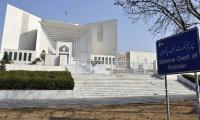ISLAMABAD: Pakistan's economy appears to be struggling less amid the coronavirus challenges compared to its regional counterparts with the country’s key economic indicators on the rise, a public policy research organisation said on Friday.
There has been improvement in purchasing power, credit to private sector and growth in large-scale manufacturing, according to Policy Research Institute of Market Economy (PRIME). In January, Pakistan prosperity index (PPI) stood at the highest mark of 126.1 points. The prosperity index reveals an encouraging picture of economic rebound, it said in a statement.
To calculate scores, the Pakistan prosperity index utilises data from Pakistan Bureau of Statistics, and State Bank of Pakistan on monthly basis. The analysis is contingent on the growth rates of four macroeconomic indicators of prosperity: trade volume, consumer price index, quantum index of large-scale manufacturing industries and long-term financing facility. On a 12-month rolling basis, this issue of the report covers the period February 2020 to January 2021, with June 2019 as the base period. The financial and business uncertainties of 2020 have been carried forward in 2021 across the globe, according to the Prime.
The PRIME’s establishes the increase in prosperity as a result of the improvement in three out of four indicators aggregated to calculate PPI namely, purchasing power, private sector credit and growth of large-scale manufacturing. Nevertheless, coronavirus lockdown affected the livelihoods of 24.9 million workers in Pakistan, a government focal person said.
The last year’s lockdown affected the livelihoods of 11.4 million daily wage workers in the formal and informal economies, and 13.5 million self-employed workers in the informal economy,” Special Assistant of Prime Minister, Poverty Alleviation and Social Safety Ministry Sania Nishtar said in a report. “Given that the average Pakistani family has 6.4 members, it is estimated that the disruption affected around 160 million people, roughly two thirds of the country’s total population.”
Purchasing power saw a modest increase as year-on-year inflation further eased in January 2021 hovering at 5.7 percent. This decelerating inflationary pressure has been characterized by a fall in the prices of basic food items. Large-scale manufacturing had consistently been on the rise since August 2020 growing by 9.13 percent year-on-year in January 2021. The recently approved electricity support package for industries and an extension in tax amnesty scheme besides the restoration of business confidence have largely been sustaining LSM’s recent growth.
Private sector borrowing also maintained its growth momentum standing at an all-time high of Rs. 249.9 billion in January 2021, largely driven by subsidised borrowing rates, restored business and investment confidence. In terms of trade, muted global demand had a ripple effect on country’s trade volume, which after increasing for two successive months last year, dipped to Rs1.12 trillion in January 2021.
“Despite the 3rd peak, the relaxed Covid-19 restrictions have played an imperative role in keeping the economic wheels moving. The country cannot afford to go under another stringent lockdown,” said the PRIME. “Therefore, the best-case scenario would be to pursue a mass vaccination drive in order to sustain the gains made in industrial and financial sector.”
Systems Limited, IT and IT-enabled services provider, hosted US Ambassador to Pakistan Donald Blome on May 3, 2024....
The logo of the Telenor Microfinance Bank . — temenos websiteKARACHI: Telenor Microfinance Bank reported a strong...
Chief Executive TDAP Mr. Zubair Motiwala met with HE Dr. Bakheet Ateeq Al-Remaiti, Consul General of UAE, in Karachi...
A representational image of gold bangles. — AFP/FileKARACHI: Gold prices in the local market dropped by Rs1,400 per...
A person walks by a sign advertising employment at a fast-food restaurant in New York City. — AFP FileWASHINGTON:...
This picture taken on January 30, 2023 shows residents buying vegetable at a market in Karachi. — AFP/FileLAHORE:...







